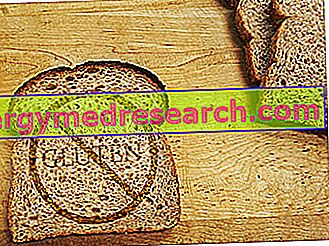Generality
Cereals and Gluten
Cereals are herbaceous plants belonging to the Poacee or Gramineae botanical genus. Certainly the most prevalent seeds rich in starch are consumed in cereals.

Not all cereals are the same; they differ for the biological species, for the botanical characteristics, for the gastronomic application of the seeds and for the relative nutritional content etc.
Some cereals, for example, contain nutritional factors not tolerated by some hypersensitive people. We are talking about gluten, a protein harmful to the health of celiacs.
In fact, cereals do not contain gluten properly. This polypeptide, which once structured resembles a "sticky net", is formed by the combination of two peptide elements (belonging to the groups of: glutelins and prolamines) in the presence of water.
As many readers will already know, gluten is an essential factor in the natural leavening of flour-and-water mixes (with the addition of sourdough, sourdough, biga, brewer's yeast); for this reason, wheat or wheat flour - the cereal that contains the most - is considered the most suitable ingredient for bread-making (bread production).
However, of the merits that gluten confers to doughs it does not matter to celiacs who, despite the fact that by introducing this protein with their diet, manifest symptoms and disorders sometimes even serious. In the long term, a celiac who systematically eats cereals with gluten risks contracting so-called celiac disease.
Wheat or wheat is therefore not the only cereal containing gluten; in the following article we will find out more about them.
What are they?
What are the cereals with gluten?
We have anticipated that, among the different cereals used in human nutrition, some of them contain two categories of peptides - gluteline and prolamine respectively; these, modifying and interacting consequently with the addition of water, form a protein called gluten. We reiterate again that wheat, one of the most important food sources in the world, is the most gluten-rich cereal.
Cereals that contain gluten are:
- Wheats - Genus Triticum ; species: durum (also kamut or ssp. turanicum ), aestivum
- Spelled - Genus Triticum ; species: monococcum, dicoccum, spelta
- Barley - Genus Hordeum; species: vulgare
- Rye - Secale Genus ; species: cereal
- Triticale - × Triticosecale : hybrid between Triticum and Secale.
Does oats contain gluten?
Recent studies ( Why Oats Are Safe and Healthy for Celiac Disease Patients - 2016) have shown that taking oats ( Avena sativa ) does not induce - in the vast majority of cases - immune-mediated epithelial reactions of the intestinal mucosa typical of celiac disease.
Oats contain avenins, similar but not equal to wheat prolamines, in quantities of 10-15% on the total protein intake (compared to 80-85% of the prolamins in the other case). The collected data tell us that it is very rare (but not impossible) that, in celiacs, the T cells of the immune system recognize and react to avenin-specific epitopes.
The analyzes carried out on the seeds provide evidence of the absence of gliadin-like peptides toxic to oats, confirming that it can definitely be considered safe for consumption by celiacs. On the other hand, the introduction of oats into the gluten-free diet of patients with celiac disease is recommended only after total recovery of intestinal health.
Does sorghum contain gluten?
In the past it was believed that sorghum, used for bread-making in Africa, also contained gluten. However, a fairly recent study ( Sorghum, a healthy and gluten-free food for celiac patients as demonstrated by genome, biochemical, and immunochemical analysis - 2013) has denied this hypothesis.
The analyzes performed on the cereal provide reliable evidence on the absence of peptides similar to gliadin, therefore toxic to celiacs, in sorghum. The findings confirm that, in the diet of celiacs, the cereal can be considered definitely safe .
This does not mean that some varieties of sorghum, now no longer used for human consumption, contained other potentially harmful active ingredients. These, which have nothing to do with gluten and celiac disease, belong to the category of cyanogenic glucosides. It goes without saying that the types of sorghum used in human nutrition are, due to genetic selection and treatment, lacking in these factors and can be considered safe.
Gluten in the Wheat
Wheat contains glutelins and prolamines which, in the presence of water, combine to form gluten.
The glutelins it contains are called glutenins, while the specific prolamins are called gliadins; the amount of gluten present in wheat is higher than most other cereals, but it should be emphasized that not all the species of this cereal contain the same portion.
As for the other species of cereals containing gluten, also in the cultivated wheat the quantity of gluten depends on the genetic selection operated by man; the oldest species (discarded due to the poor yield of the plant and a lower quantity of gluten) are certainly qualitatively better, but the food industry prefers "re-crossed" cereals because they are more profitable and resistant.
Note : the choice to obtain flours with a high quantity of gluten is justified by the importance of this protein in bread making.
Celiac disease
Currently, cereals containing gluten are denigrated because of the diagnostic increase in celiac disease, the specific intolerance towards this protein.
In addition to the overt cases, it is possible to recognize a series of atypical extra-enteric symptoms that seem to unite many subjects with negative results for celiac disease tests; at the moment it is very difficult to establish whether this is a sort of collective hysteria dictated by the trend, a concrete reaction linked to the irritability of the colon or a real collective hypersensitivity.
The fact remains that cereals containing gluten are a very important source of livelihood, therefore, before unfairly demonizing them, it is advisable to wait for scientific experiments that prove or deny the hypersensitivity mechanisms linked to the intake of this protein.



